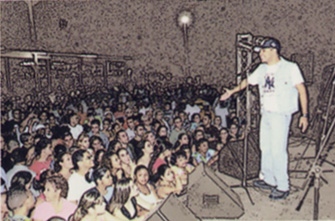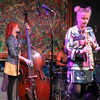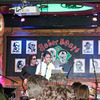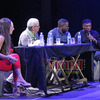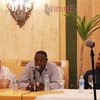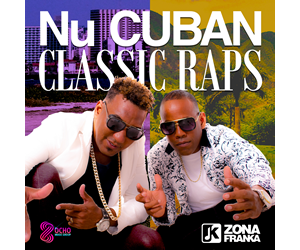Indice - Table of contents
New Stuff[hide]
Staff: Bill Tilford
Reportes: From The St... : Jazz Plaza ...
Fotos: Tom Ehrlich : Irakere 50th Annivers...
Fotos: Tom Ehrlich : Irakere
Resenas: Joey Altruda Presents: El Gran ...
Timbapedia: 09. Interviews -... : Carlos del Pino ...
Fotos: Tom Ehrlich : 2023 Monterey Jazz Fe...
Fotos: Tom Ehrlich : 2023 Monterey Jazz Fe...
Fotos: Tom Ehrlich : 2023 Monterey Jazz Fe...
Fotos: Tom Ehrlich : 2023 Monterey Jazz Fe...
Grupos: Tirso Duarte
Grupos: Tirso Duarte : Discography
Grupos: Charanga Habaner... : 8. El bla bla bla
Grupos: Pupy y los que S... : Tirso Duarte
Photos of the Day [hide]
SpanishEnglishDiscography - El puente - La bola
La bola
In 2000, when Manolín left his band in Miami and returned to Cuba, the government made it impossible for him to perform as a bandleader, so he started appearing as a guest artist with groups like NG La Banda and Paulito FG, borrowing those musicians to form an impromptu band of pseudo-Chamacos. But, as I keep repeating, constant rehearsal is the lifeblood of Timba, and these shows were quite horrible. After one or two poorly-rehearsed arrangements, the show would inevitably come down to a 25-minute version of La bola, with the rent-a-musicians repeating the basic La bola tumbao while Manolín tried to fit the hooks from all of his other songs on top of that chord progression. Manolín finally succeeded in putting together an absolutely extraordinary band in late 2000, featuring Yoel Páez, Joel Domínguez, Alexander Abreu, José Miguel, and even, briefly, Sergio Noroña. They played four concerts -- timba.com's Majela Serrano attended one, and our newest contributor, Thomas Voirol, was present at another -- but the cultural authorites had the shortsighted audacity to refuse them a license on the ludicrous grounds that they were not musically-qualified! The impact of this shallow victory of politics over art reached far beyond the intended goal of discouraging one trouble-making singer. The Havana scene had already begun to decline from its late-90's zenith and it badly needed a new and powerful creative force, which that unbelievably strong band most certainly would have been, had it been allowed to succeed. Ironically, just as the Russians, the Cubans and the Americans inadvertantly created the perfect environment in which Timba could thrive, they're now -- just as unwittingly -- sabotaging it at every turn.
In any case, after he left his band in Miami, the great majority of Manolín's performances in Cuba consisted primarily of laughably bad, interminably long versions of La bola, and I grew to hate the song from listening to these hack jobs, but the El puente version has forcefully reminded me just how great a song it is when performed properly. Manolín sings it with such intensity and enthusiasm at Rancho Gaspar that you might think he'd just written the song. The new arrangement also has many enhancements and additions.
The cuerpo has been completely redone. It's now sung as a coro with a driving groove featuring a synth-kalimba part. [audio example 35] This is one of several places in this set where the harmonies are reworked to convert passages which were originally in major to minor, and it's very effective.
Cuban lyricists have been refining the art of the double entendre for years and for Manolín it's served as an insurance policy for this song, because it can still be considered a love song even though he's now put himself on the losing end of the scenario implied between the lines of his of own song.
In the cuerpo, Manolín seems to be singing to his lover's ex - "look pal, you left her -- but you lost out because I came along and stayed with her, and now she's mine -- now I'm the king". But the coro can also be interpreted as Manolín singing to other artists who fled Cuba in search of greener pastures. Manolín, at that time, had chosen to stay and pursue his musical destiny there, and by the time this coro was written he was in fact "the king" of the Havana music scene. Since then, however, Manolín has left Cuba...three times. Furthermore, Willie Chirino is in no danger of being replaced by him as the king of Miami's highly-questionable music scene. Finally, judging by his artistic output since leaving Cuba, Manolín has clearly lost out in terms of producing great music -- the legacy by which he'll ultimately be judged -- so the irony runs triple-thick on this particular coro.
Irony, irony everywhere ... pero ironía con swing! El rey o no el rey, La bola is fully worthy of its massive success, unlike some more recent smash hits like Yo soy malo cantidad and La vida es un carnaval. The 3-part coro masterpiece below should be ample evidence that as an inventor of coros, Manolín stands head and shoulders above everyone else. Manolín never takes the obvious solution, as is so typical in salsa. A coro can be judged in many ways: melody, rhythm, rhyme, meaning, and perhaps most important, the natural flow of the words, and Manolín seldom lets a coro go out until it has something unique to offer in each area.
Each of the sections is repeated several times. The first features nice internal rhyming and strong guías from Manolín; the rhythm section helps raise the intensity of the second by playing in bomba gear; and the third, the most famous of all, is the other kind of trablenguas -- a genuine tongue-twister. Also note that in this excerpt, this third section is played in minor, a nice change of pace that was added in recent years.
tú te fuiste
[you left]
y si te fuiste perdiste
[and if you left, you lost out]
yo no
[not me]
yo me quedé
[I stayed]
y ahora soy el rey
[and now I'm the king]
y si te gusta, bien
[if you like it, fine]
y si no, también
[and if you don't like it, that's fine too]
por que hay que estar arriba de la bola arriba de la bola
por que hay que estar arriba de la bola arriba de la bola arriba de la bola
[because you've got to stay on the ball]
[audio example 36]
As the concert builds to the close, Manolín introduces two additional coros. The first is an old one that was never recorded and dates back to his famous onstage feuds with Paulito before the two became great friends. (It's likely that both the feud and friendship were at least partially for show!).
me voy pero vuelvo pronto
{I'm going but I'll be back soon]
me voy y no quiero invento
[I'm going but I don't want any fooling around]
y cuando vuelva no quiero intriga
[and when I come back I don't want any hanky-panky]
guajacones, pa' la orilla
[no go on, you little tadpole, swim to shore!]
And finally, derived from nursery rhyme from a Cuban television show:
abuela, ¿qué pasaría?
[grandma - what would happen...]
si por una brujería yo resbalo y de repente me cayera
[if a witch's spell makes me slip and fall down ?]
[audio example 37]
Manolín departs after saluting la gente de Coral Gables, la gente de Kendall, etc. Somehow the names of these "barrios" don't sound as romantic as those have been immortalized by so many great Cuban songs -- Cayo Hueso, Vedado, Cero, Buena Vista, Miramar...
Perhaps some day they will.
Special thanks to: Majela Serrano, Juan Tomás García, Gabriel Wilder.
